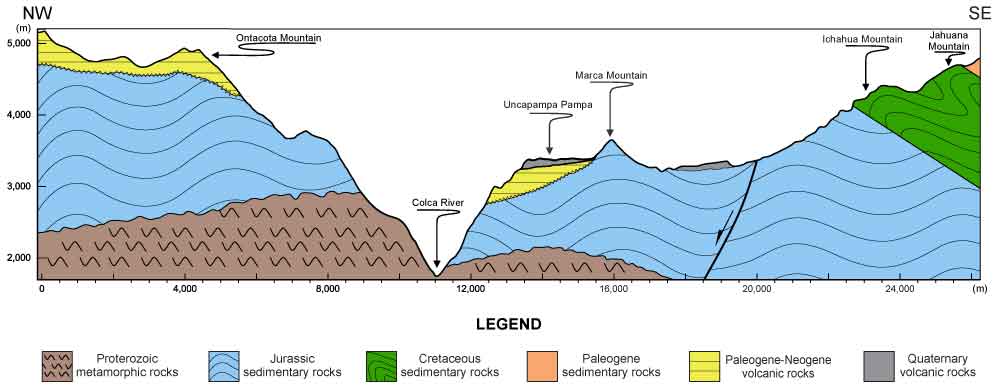
Northeastern view Colca Canyon. Right: Quaternary volcanic rocks on the surface, intersected by normal fault; to the backdrop: Plio-Quaternary volcanic arc glacial mountains.
Geological Period
Paleoproterozoic (Statherian) to Holocene
Main geological interest
Tectonics
Geomorphology and active geological processes
Location
Arequipa, Peru
15°36’41”S, 071°54’21”W
Northeastern view Colca Canyon. Right: Quaternary volcanic rocks on the surface, intersected by normal fault; to the backdrop: Plio-Quaternary volcanic arc glacial mountains.
1800 millions years of Earth´s history including six geological periods of active continental margins located in one of the deepest canyons on Earth.
The Colca River canyon exposes a unique section of lithosphere in the Central Andes with rocks of different origin, age, lithology and tectonic structures, in 120-kilometer-long continuous walls 1-3 kilometer high. Located in the Western Cordillera of southern Peru, it is one of the deepest valleys in the Andes. The incision is strictly related to active tectonic processes related to the subduction zone of the Nazca Plate below the South American Plate. The Andes, and especially its middle sector channeled by the Colca River, are considered a model of active continental margin (Paulo, 2008).
- Geological description
The Colca Canyon, an important tourist destination in Peru, records six geological periods between the Proterozoic (Statherian) and Phanerozoic Eons (Quaternary). At its base lies a Paleo-Proterozoic metamorphic basement intruded by Cretaceous-Paleogene plutons (Caldas, 1993; Romero, 2001) and unconformably overlaid by folded and faulted Jurassic and Cretaceous rocks containing marine fossils (logs and footprints). The Western Andean Volcanic Arc contributes a vast Cenozoic volcanic cover. Resting on an Eocene-Miocene basement, eroded Plio-Pleistocene stratovolcanoes and active Pleistocene-Holocene stratovolcanoes (e.g., Sabancaya volcano) are prominent, alongside monogenetic cones and fissural lava fields. The rocky mountainous front (1000 to 5200 meters asl) is covered by moraines, glacial meltwater, alluvium, lakes, and rock avalanches deposits. The Colca´s neotectonic, volcanic and seismicity activity is related to active faults within the Quaternary Volcanic Arc, where the Colca fault system has the most representative structures (Benavente et al., 2017; Delacourt et al., 2007; Rivera et al., 2016). The Colca Canyon incision is a result of the Andean uplift, deglaciation, and erosion in 120 kilometers of escarpments between 1 to 3 kilometers. The primitive canyon must have started about 10 million years ago; its current landscape would correspond to the last million years (Thouret et al., 2007).
- Scientific research and tradition
The Colca Canyon, an important tourist destination in Peru, records six geological periods between the Proterozoic (Statherian) and Phanerozoic Eons (Quaternary). At its base lies a Paleo-Proterozoic metamorphic basement intruded by Cretaceous-Paleogene plutons (Caldas, 1993; Romero, 2001) and unconformably overlaid by folded and faulted Jurassic and Cretaceous rocks containing marine fossils (logs and footprints). The Western Andean Volcanic Arc contributes a vast Cenozoic volcanic cover. Resting on an Eocene-Miocene basement, eroded Plio-Pleistocene stratovolcanoes and active Pleistocene-Holocene stratovolcanoes (e.g., Sabancaya volcano) are prominent, alongside monogenetic cones and fissural lava fields. The rocky mountainous front (1000 to 5200 meters asl) is covered by moraines, glacial meltwater, alluvium, lakes, and rock avalanches deposits. The Colca´s neotectonic, volcanic and seismicity activity is related to active faults within the Quaternary Volcanic Arc, where the Colca fault system has the most representative structures (Benavente et al., 2017; Delacourt et al., 2007; Rivera et al., 2016). The Colca Canyon incision is a result of the Andean uplift, deglaciation, and erosion in 120 kilometers of escarpments between 1 to 3 kilometers. The primitive canyon must have started about 10 million years ago; its current landscape would correspond to the last million years (Thouret et al., 2007).
- Reference
Paulo, A. (2008) ‘Geology of the Western Cordillera in Southern Peru – an outline’, in Polskie badania w Kanionie Colca i Dolinie Wulkanów. Cracovia (English and Polish), pp. 35–53.
Schildgen, T.F. et al. (2007) ‘Uplift of the western margin of the Andean plateau revealed from canyon incision history, southern Peru’, Geology, 35(6), pp. 523–526. Available at: https://doi.org/10.1130/G23532A.1.
Schildgen, T.F. et al. (2009) ‘Late Cenozoic structural and tectonic development of the western margin of the central andean plateau in southwest Peru’, Tectonics, 28(4). Available at: https://doi.org/10.1029/2008TC002403.
Thouret, J.-C. et al. (2007) ‘Geochronologic and stratigraphic constraints on canyon incision and Miocene uplift of the Central Andes in Peru’, Earth and Planetary Science Letters, 263(3), pp. 151–166. Available at: https://doi.org/10.1016/j.epsl.2007.07.023.
- Author(s)
Bilverto Zavala Carrión.
Instituto Geológico Minero y Metalúrgico-INGEMMET. Perú.
Carlos Benavente Escobar.
Instituto Geológico Minero y Metalúrgico. Perú.
Igor Astete Farfán.
Instituto Geológico Minero y Metalúrgico – INGEMMET. Perú.


